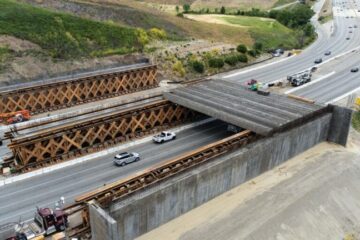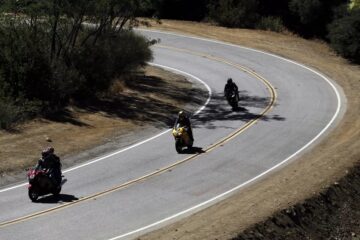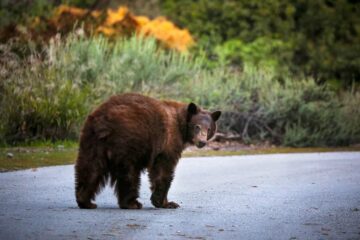Scientists track cougar’s wild nightlife above Hollywood
The mountain lion — known as P-22 — living in Griffith Park is giving scientists insight into the behavior of an urban puma on the prowl.
Source of this article: The Los Angeles Times, October 5, 2013.
For more than a year and a half, the solitary mountain lion known as P-22 has made himself right at home in Griffith Park within view of Hollywood’s Capitol Records building.

The lights of Hollywood glow behind P-22, a 125-pound mountain lion in Griffith Park. The photo was taken by Steve Winter with a remote trail camera and will be published in December’s National Geographic magazine. Winter’s work will appear in “The Power of Photography: National Geographic 125 Years” at the Annenberg Space for Photography, opening Oct. 26.
By night, he cruises the chaparral-covered canyons, dining on mule deer, raccoon and coyote. By day, while tots ride the Travel Town train and hikers hit the trails, he hunkers down amid dense vegetation.
To researchers’ knowledge, the 125-pound 4-year-old is the most urban mountain lion in Southern California and possibly beyond — surviving and thriving in a small patch of habitat surrounded by freeways and densely packed human beings that he reached, somewhat miraculously, by crossing the 101 and 405 freeways.
P-22 is giving scientists insight into the life and eating habits of a puma on the prowl. And he is serving as an unwitting but alluring subject for a National Geographic wildlife photographer whose trail cameras have captured jaw-dropping nighttime shots of the animal, including one that features the Hollywood sign.
“He has it quite easy for a young lion in Griffith Park,” said Jeff Sikich, a National Park Service biologist tracking P-22. “There’s no competition, and there seems to be plenty of prey for him.”
Sikich, part of a National Park Service team that has captured and collared more than 20 cougars in the Santa Monica Mountains during a long-term study, is among a small group of scientists who have studied P-22’s behavior since March 2012.
If hikers, equestrians or other park users have encountered P-22 during the day, they haven’t alerted Sikich. He said that there has been “possibly one credible sighting” but that the lion has been “doing what a lion should do: finding his natural prey and staying elusive.”
Biologists say P-22 probably entered the park in February 2012, after a journey of 20 miles or so from farther west in the Santa Monica Mountains.
Sometime later, the mountain lion triggered a remote camera set up for a wildlife survey. On Feb. 29, 2012, Miguel Ordeñana, a biologist working on the survey, began culling a couple of weeks’ worth of mundane images of deer and coyotes. Hoping for a bobcat, he was startled to see the massive hindquarters and tail of a much larger animal. He later found the first photo of the lion, which showed his face.
“From what I’d been told and what I knew, it was seemingly nearly impossible for a mountain lion to be there,” he said. “I almost thought I had seen Bigfoot or a chupacabra.” (A chupacabra is a ferocious, blood-sucking creature of urban legend.)
Although a dead cougar was found in the park in 1995, and parkgoers reported sightings in 2004, this was the first photographic evidence of a lion inhabiting the park. In fact, the photos taken were the first known images of any mountain lion within the mountain system east of Cahuenga Pass, the National Park Service said.
Sikich set humane traps with cameras, rigged to send images to his cellphone. At 2 o’clock one morning in March 2012, his cellphone rang, and he and other scientists hurried to the site, a Department of Water and Power property just west of the park. Sikich used a blowpipe to administer a sedative to the mountain lion and attached a collar with GPS and very high frequency radio signal technology.
The collar regularly sends data to a website via satellite or cellphone tower. Biologists remotely track an average of eight locations a day, mostly at night when the animal is active. They watch particularly for “location clusters,” indicating spots where the lion has been feeding.
Using the location data as a guide, they have bushwhacked or crawled through poison oak and thick vegetation to find what was on P-22’s menu. Once in the vicinity, they follow their noses.
“For fresh kills, smell is very telling; it smells like rotten meat,” said Laurel Serieys a PhD candidate in biology at UCLA who’s a project volunteer.
She and Ordeñana recently spent four arduous hours hiking in to four “kill sites” in deep ravines or on steep hillsides. At the first location, right off a paved road in the park, they found only the malodorous rumen, or stomach, of a deer. They surmised that coyotes had dragged the deer’s body away.
Next, at the bottom of a ravine, Serieys found a coyote carcass, with part of the muzzle intact. Ordeñana said this was the first documented P-22 kill that was not a deer. Their excitement at the discovery was tempered by a concern: Coyotes eat rodents that have been exposed to rat poison. Two mountain lions that were collared for the National Park Service study died from rodenticide poisoning.
At the third site, they found a rib cage and skull with antlers attached: another mule deer.
Deep in a poison oak-infested ravine in the southeast part of the park, near Farmouth Drive, they found the fourth and goriest carcass — a big raccoon with bloody limbs scattered all about. (In contrast with the all-you-can-eat buffet of a 150-pound mule deer, the raccoon could be considered more of a protein bar snack.)
It appeared that P-22 had tried to camouflage the kill under a pile of leaves but that coyotes had also feasted. Ordeñana described the scene on the website Urban Carnivores. “It seemed as if P-22 and maybe later some coyotes attempted to consume almost every morsel of available meat to the point where it seemed like the carcass was turned inside out.”
“There’s a possibility that, even though we say mountain lions are deer specialists, they probably are more of a generalist carnivore than we think,” Ordeñana said.
Researchers aren’t the only ones thrilled by the unprecedented opportunities P-22 provides with his ongoing presence in Los Angeles’ Griffith Park.
Steve Winter, a contributing photographer to National Geographic magazine, has gotten several perfectly framed shots of the cougar on his nocturnal rounds, with the lights of Hollywood as a backdrop. The image featured with this story, which Winter’s camera took at 3:46 a.m. on March 2, will be published in the magazine’s December issue. Winter’s P-22 images will also appear in “The Power of Photography: National Geographic 125 Years” at the Annenberg Space for Photography, opening Oct. 26.
Winter, working as part of a National Geographic program to foster awareness of the plight of wild cats, met Sikich at a 2011 mountain lion workshop in Bozeman, Mont.
“We need an image of urban cats because we know they’re coming close to urban areas and small towns,” Winter recalled telling Sikich. “Wouldn’t it be great to get a picture of a mountain lion under the Hollywood sign?” At the time, Winter said, Sikich considered it a long shot. After P-22 ambled into the park, however, Sikich helped Winter set up cameras, remotely triggered by infrared beams, in locked steel boxes in scattered locations.
Winter, too, has had to deal with predators. “Three setups were stolen,” he said. Some Hollywood Hills residents help keep an eye on the equipment and email to let him know its condition.
For now, P-22 remains what Ordeñana calls the “ultimate living ambassador for Griffith Park wildlife and urban mountain lions.” But Sikich knows that biology will almost certainly dictate a relocation from P-22’s 8-square-mile home to much larger terrain.
“Eventually, he’s going to want to breed,” Sikich said. “And that might bring him out of there.”



0 Comments